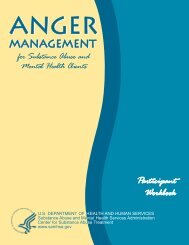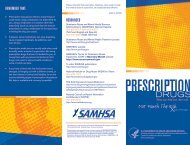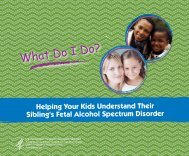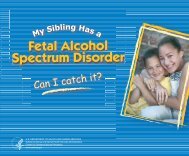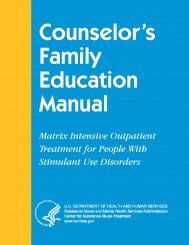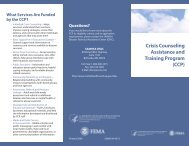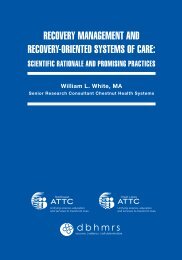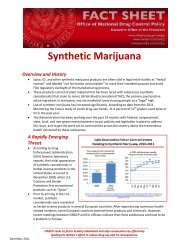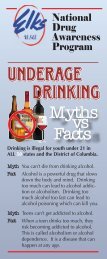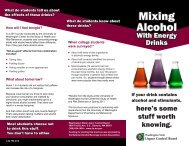Counselor's Manual for Relapse Prevention With Chemically ...
Counselor's Manual for Relapse Prevention With Chemically ...
Counselor's Manual for Relapse Prevention With Chemically ...
You also want an ePaper? Increase the reach of your titles
YUMPU automatically turns print PDFs into web optimized ePapers that Google loves.
ecovery plan to determine whether he or she completed the required activities and experiencedany relapse warning signs.Whenever possible, these inventories should be reviewed by someone who knows the patient andwho can assist him or her in looking <strong>for</strong> emerging patterns of problems that could cause relapse.Principle 8: Significant OthersThe risk of relapse will decrease as the responsible involvement of significant others in recoveryand in relapse prevention planning increases.<strong>Relapse</strong> <strong>Prevention</strong> Procedure 8: Involvement of Others<strong>Relapse</strong>-prone individuals cannot recover alone. They need the help of others. Family members,12-step program sponsors, counselors, and peers are just a few of the many recovery resourcesavailable. A counselor should ensure that others are involved in the recovery process wheneverpossible. The more psychologically and emotionally healthy the significant others are, the morelikely they are to help the relapse-prone patient remain abstinent. The more directly thesignificant others are involved in the relapse prevention planning process, the more likely theyare to become productively involved in supporting positive ef<strong>for</strong>ts at recovery and intervening onrelapse warning signs or initial chemical use.Principle 9: MaintenanceThe risk of relapse decreases if the relapse prevention plan is regularlyupdated during the first 3years of sobriety.<strong>Relapse</strong> <strong>Prevention</strong> Procedure 9: <strong>Relapse</strong> <strong>Prevention</strong> Plan UpdatingThe patient's relapse prevention plan needs to be updated on a monthly basis <strong>for</strong> the first 3months, quarterly <strong>for</strong> the remainder of the first year, and twice a year <strong>for</strong> the next 2 years. Once aperson has maintained 3 years of uninterrupted sobriety, the relapse prevention plan should beupdated on a yearly basis.Nearly two thirds of all relapses occur during the first 6 months of recovery. Less than onequarter of the variables that actually cause relapse can be predicted during the initial treatmentphase. As a result, ongoing outpatient treatment is necessary <strong>for</strong> effective relapse prevention.Even the most effective short-term inpatient or primary outpatient programs will fail to interruptlong-term relapse cycles without the ongoing rein<strong>for</strong>cement of some type of outpatient therapy.A relapse prevention plan update session involves the following:A review of the original assessment, warning sign list, management strategies, and recoveryplan.



